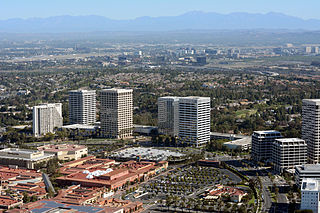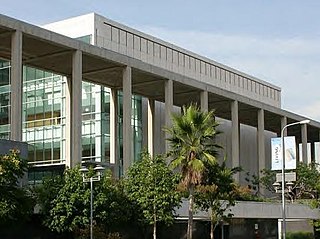
The Los Angeles Music Center is one of the largest performing arts centers in the United States. Located in downtown Los Angeles, The Music Center is composed of the Dorothy Chandler Pavilion, Ahmanson Theatre, Mark Taper Forum, Roy & Edna Disney CalArts Theatre (REDCAT), and Walt Disney Concert Hall.

The Dorothy Chandler Pavilion is one of the halls in the Los Angeles Music Center, which is one of the largest performing arts centers in the United States. The Music Center's other halls include the Mark Taper Forum, Ahmanson Theatre, and Walt Disney Concert Hall.

Fashion Island is an outdoor regional shopping mall in Newport Beach, California. Opened in 1967 by The Irvine Company as the anchor to their master-planned Newport Center district, Fashion Island is anchored by Bloomingdale's, Macy's, Neiman Marcus, and Nordstrom.

Welton David Becket was an American modern architect who designed many buildings in Los Angeles, California.

The Civic Center neighborhood of Los Angeles, California, is the administrative core of the City of Los Angeles, County of Los Angeles, and a complex of city, county, state, and federal government offices, buildings, and courthouses. It is located on the site of the former business district of the city during the 1880s and 1890s, since mostly-demolished.

Santa Monica Civic Auditorium is a multi-purpose convention center at 1855 Main Street in Santa Monica, California, owned by the City of Santa Monica. It was built in 1958 and designed by Welton Becket and as a concert venue, it has a seating capacity of 3,000.
Ellerbe Becket was an independent Minneapolis, Minnesota-based architectural, engineering, interior design and construction firm until 2009, when it was acquired by AECOM.

Center Theatre Group is a non-profit arts organization located in Los Angeles, California. It is one of the largest theatre companies in the nation, programming subscription seasons year-round at the Mark Taper Forum, the Ahmanson Theatre and the Kirk Douglas Theatre.

Westfield Century City is a two-level, 1,300,000-square-foot (120,000 m2) outdoor shopping mall in the Century City commercial district in Los Angeles, California. A property of the Westfield Corporation, the mall features Nordstrom, Macy's, Bloomingdale's, in addition to a Gelson's supermarket, and a 15-screen AMC multiplex.

The Ahmanson Theatre is one of the four main venues that compose the Los Angeles Music Center.
The Latino Theater Company (LTC) is a theatre producing organization based in Los Angeles, California.
S. (Sydney) Mark Taper was a Polish-born British-American real estate developer, financier and philanthropist in London and Southern California. His 1962 gift to the Los Angeles Music Center resulted in the Mark Taper Forum being named for him in 1967.

Gordon Davidson was an American stage and film director and the founding artistic director of Center Theatre Group in Los Angeles.

The Capitol Records Building, also known as the Capitol Records Tower, is a 13-story tower building in Hollywood, California. Designed by Louis Naidorf of Welton Becket Associates, it is one of the city's landmarks. Construction began soon after British music company EMI acquired Capitol Records in 1955, and was completed in April 1956. Located just north of the Hollywood and Vine intersection, the Capitol Records Tower houses the consolidation of Capitol Records' West Coast operations and is home to the recording studios and echo chambers of Capitol Studios. The building is a Los Angeles Historic-Cultural Monument and sits in the Hollywood Boulevard Commercial and Entertainment District. It has been described as the "world's first circular office building."
Martin Aronstein was an American lighting designer whose Broadway career spanned thirty-six years.

The Nimoy Theater, formerly known as Crest, Majestic Crest and Bigfoot Crest Theatre, is a movie theatre located in the Westwood neighborhood of Los Angeles, California. It was founded as the UCLAN in 1941, and was built for live performances but switched to a newsreel cinema during World War II. Through ownership changes, it has been known at various times as UCLAN Theatre, Crest Theatre, and Metro Theatre. The original 500-seat art deco style theater was designed by Arthur W. Hawes.
Grand Avenue is a major north–south thoroughfare in Los Angeles, California. Primarily located in downtown's Bunker Hill, Financial, and South Park districts, the avenue features many of the area's most notable destinations, and is also connected to City Hall via Grand Park.

New Formalism is an architectural style that emerged in the United States during the mid-1950s and flowered in the 1960s. Buildings designed in that style exhibited many Classical elements including "strict symmetrical elevations" building proportion and scale, Classical columns, highly stylized entablatures and colonnades. The style was used primarily for high-profile cultural, high tech, institutional and civic buildings. Edward Durrell Stone's New Delhi American Embassy (1954), which blended the architecture of the east with modern western concepts, is considered to be the symbolic start of New Formalism architecture.
Christine Kellogg is an American choreographer and director and she is the artistic director of PenArts.
















